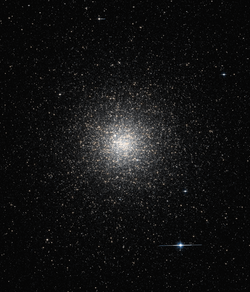Astronomy:NGC 6441
| NGC 6441 | |
|---|---|
 | |
| Observation data (J2000 epoch) | |
| Constellation | Scorpius |
| Right ascension | 17h 50m 13.06s[1] |
| Declination | −37° 03′ 05.2″[1] |
| Distance | 42.7 ± 2.3 kly (13.1 ± 0.7 kpc)[2] |
| Apparent magnitude (V) | 7.2[3] |
| Apparent dimensions (V) | 9.6′[3] |
| Physical characteristics | |
| Mass | 1.6×106[4] M☉ |
| Radius | 4.8[5] |
| Tidal radius | 88.8 ly (27.23 pc)[6] |
| Metallicity | [math]\displaystyle{ \begin{smallmatrix}\left[\ce{Fe}/\ce{H}\right]\end{smallmatrix} }[/math] = −0.53[7] dex |
| Estimated age | 13−13.7[5] Gyr |
| Other designations | GCl 78, CD−37° 11916, CPD−37° 7530, HD 161968[8] |
NGC 6441 is a globular cluster in the southern constellation of Scorpius. It was discovered by the Scottish astronomer James Dunlop on May 13, 1826, who described it as "a small, well-defined rather bright nebula, about 20″ in diameter". The cluster is located 5 arc minutes east-northeast of the star G Scorpii,[3] and is some 43,000 light-years from the Sun.[2]
This is one of the most massive and luminous globular clusters in the Milky Way, with an estimated 1.6 million solar masses of stars. It is located in the bulge of the galaxy at a distance of 13 kilolight-years (3.9 kpc) from the core,[6] and is considered metal "rich". That is, it has a relatively high abundance of elements with higher mass than helium.[4] The core region of the cluster subtends an angle of 0.11 arc minutes, compared to the half-mass radius of 0.64 arc minutes. The density of stars in the core region is indicated by the luminosity density: 5.25 L⊙ pc−3.[5] The cluster has a half-light radius of 7.1 ly (2.18 pc).[6]
This cluster has an abnormally large number of RR Lyrae variables—68 candidates as of 2006, and their periods are longer than is typical for their respective metallicities. (The mean period for the cluster's RRab stars is 0.759 day.) There are also several type II Cepheid stars, which is unusual given the high metallicity of this cluster.[9] Examination of the red giant branch section of the color-magnitude diagram suggests that there are at least two and possibly three distinct populations in the cluster. The brightest and higher temperature members of the red clump stars are more concentrated toward the center of the cluster. This group may be a helium-enriched second generation of stars.[10]
The cluster contains at least four millisecond pulsars, of which two are in binary systems. One of these binaries, PSR J1750−37A, is in a highly eccentric orbit with an eccentricity of 0.71.[5] The cluster has an X-ray burster, X1746-370, which has the longest period known in any globular cluster and is consistent with the galaxy as a whole.[11] Finally, there is a planetary nebula, JaFu 2,[12] one of only four planetary nebulas known to inhabit globular clusters in the Milky Way.[3]
References
- ↑ 1.0 1.1 Goldsbury, Ryan et al. (December 2010), "The ACS Survey of Galactic Globular Clusters. X. New Determinations of Centers for 65 Clusters", The Astronomical Journal 140 (6): 1830–1837, doi:10.1088/0004-6256/140/6/1830, Bibcode: 2010AJ....140.1830G.
- ↑ 2.0 2.1 Oliveira, R. A. P.; Ortolani, S.; Barbuy, B.; Kerber, L. O.; Maia, F. F. S.; Bica, E.; Cassisi, S.; Souza, S. O. et al. (2022). "Precise distances from OGLE-IV member RR Lyrae stars in six bulge globular clusters". Astronomy & Astrophysics 657: A123. doi:10.1051/0004-6361/202141596. Bibcode: 2022A&A...657A.123O.
- ↑ 3.0 3.1 3.2 3.3 O'Meara, Stephen James (2013), Deep-Sky Companions: Southern Gems, Cambridge University Press, pp. 360–363, ISBN 978-1139851541, Bibcode: 2013dcsg.book.....O, https://books.google.com/books?id=BoIsCgAAQBAJ&pg=PA360
- ↑ 4.0 4.1 Bellini, A. et al. (March 2013), "The Intriguing Stellar Populations in the Globular Clusters NGC 6388 and NGC 6441", The Astrophysical Journal 765 (1): 27, doi:10.1088/0004-637X/765/1/32, 32, Bibcode: 2013ApJ...765...32B.
- ↑ 5.0 5.1 5.2 5.3 Freire, Paulo C. C. et al. (March 2008), "Eight New Millisecond Pulsars in NGC 6440 and NGC 6441", The Astrophysical Journal 675 (1): 670–682, doi:10.1086/526338, Bibcode: 2008ApJ...675..670F.
- ↑ 6.0 6.1 6.2 Mackey, A. D.; van den Bergh, Sidney (June 2005), "The properties of Galactic globular cluster subsystems", Monthly Notices of the Royal Astronomical Society 360 (2): 631–645, doi:10.1111/j.1365-2966.2005.09080.x, Bibcode: 2005MNRAS.360..631M.
- ↑ Leaman, Ryan (December 2012), "Insights into Pre-enrichment of Star Clusters and Self-enrichment of Dwarf Galaxies from Their Intrinsic Metallicity Dispersions", The Astronomical Journal 144 (6): 13, doi:10.1088/0004-6256/144/6/183, 183, Bibcode: 2012AJ....144..183L.
- ↑ "NGC 6441". SIMBAD. Centre de données astronomiques de Strasbourg. http://simbad.u-strasbg.fr/simbad/sim-basic?Ident=NGC+6441.
- ↑ Corwin, T. Michael et al. (September 2006), "Image-Subtraction Photometry of Variable Stars in the Globular Clusters NGC 6388 and NGC 6441", The Astronomical Journal 132 (3): 1014–1022, doi:10.1086/505745, Bibcode: 2006AJ....132.1014C.
- ↑ Krogsrud, David A. et al. (April 2013), "The Curious Radial Distributions of Horizontal Branch Stars in NGC 6441", The Astrophysical Journal Letters 767 (2): 5, doi:10.1088/2041-8205/767/2/L27, L27, Bibcode: 2013ApJ...767L..27K.
- ↑ Homer, L. et al. (June 2002), "Optical Identification of the X-Ray Burster X1746-370 in the Globular Cluster NGC 6441", The Astronomical Journal 123 (6): 3255–3262, doi:10.1086/340470, Bibcode: 2002AJ....123.3255H.
- ↑ Jacoby, George H. et al. (December 1997), "Planetary Nebulae in the Globular Cluster PAL 6 and NGC 6441", Astronomical Journal 114: 2611, doi:10.1086/118671, Bibcode: 1997AJ....114.2611J.
External links
 |

